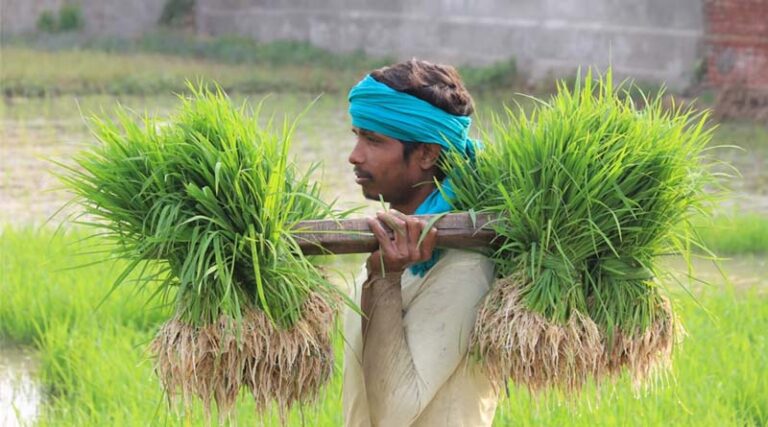
Kharif 2025 Crop Coverage Shows Mixed Trends: Rice and Coarse Cereals Expand, Oilseeds See Decline
02 October 2025, New Delhi: The Ministry of Agriculture & Farmers Welfare has released the latest figures on the progress of area coverage under kharif crops for the 2025–26 season, as on 26 September 2025. The data highlights an overall increase in sowing compared to the previous year, with notable gains in rice, coarse cereals, and sugarcane, while oilseeds and cotton registered a decline.
Comparative Table: Area Coverage under Kharif Crops (in lakh hectares)
| Crop Category | Normal Area (2019–20 to 2023–24) | Area Sown 2025–26 | Area Sown 2024–25 | Increase/Decrease over 2024–25 |
|---|---|---|---|---|
| Rice | 403.09 | 441.58 | 435.68 | +5.91 |
| Pulses | 129.61 | 119.85 | 118.95 | +0.90 |
| – Tur | 44.71 | 46.31 | 46.39 | -0.08 |
| – Kulthi | 32.64 | 24.29 | 22.87 | +1.42 |
| – Urad | 35.69 | 34.84 | 34.96 | -0.12 |
| – Moong | 1.72 | 0.67 | 0.56 | +0.12 |
| – Other Pulses | 9.70 | 9.24 | 9.63 | -0.40 |
| – Moth Bean | 5.15 | 4.51 | 4.55 | -0.04 |
| Coarse Cereals | 180.71 | 194.67 | 182.66 | +12.01 |
| – Jowar | 15.07 | 14.07 | 14.15 | -0.08 |
| – Bajra | 70.69 | 68.44 | 68.65 | -0.21 |
| – Ragi | 11.52 | 11.81 | 11.00 | +0.81 |
| – Maize | 4.48 | 5.39 | 4.56 | +0.84 |
| – Other Millets | 78.95 | 94.95 | 84.30 | +10.65 |
| Oilseeds | 194.63 | 190.01 | 200.52 | -10.52 |
| – Groundnut | 45.10 | 48.31 | 49.96 | -1.65 |
| – Sesamum | 127.19 | 120.45 | 129.55 | -9.10 |
| – Sunflower | 1.29 | 0.70 | 0.73 | -0.02 |
| – Soybean | 10.32 | 10.50 | 11.07 | -0.56 |
| – Niger Seed | 1.08 | 1.02 | 0.98 | +0.05 |
| – Castor Seed | 9.65 | 8.94 | 8.17 | +0.77 |
| – Other Oils | 0.00 | 0.08 | 0.07 | +0.01 |
| Sugarcane | 52.51 | 59.07 | 57.22 | +1.86 |
| Jute & Mesta | 6.60 | 5.56 | 5.75 | -0.18 |
| Cotton | 129.50 | 109.98 | 112.95 | -2.97 |
| Total | 1096.65 | 1120.73 | 1113.72 | +7.01 |
Crosswise Analysis
The total kharif area under cultivation this year stands at 1120.73 lakh hectares, an increase of 7.01 lakh hectarescompared to last year, and a notable 24.08 lakh hectares higher than the normal area (2019–20 to 2023–24 average).
Rice, the staple crop, has maintained its dominance with 441.58 lakh hectares sown, which is 5.91 lakh hectares more than the previous year and well above its normal average. The robust coverage suggests favorable conditions and higher farmer preference, possibly due to strong procurement prospects.
Pulses recorded only a marginal increase of 0.90 lakh hectares compared to 2024–25. Within this group, Kulthi made the most significant gain, rising from 22.87 to 24.29 lakh hectares, while Tur and Urad showed small declines. Moong also saw a modest recovery, though its sown area remains low compared to the normal average.
A striking trend is seen in Coarse Cereals, which surged by 12.01 lakh hectares over the last year. This rise was driven primarily by Other Small Millets, which jumped by over 10 lakh hectares compared to 2024–25. Both Ragi and Maizealso contributed positively, while Jowar and Bajra recorded slight declines. This shift points towards renewed interest in millets, aligning with government and global campaigns for their nutritional and climate-resilient benefits.
In contrast, Oilseeds saw a significant contraction of 10.52 lakh hectares compared to last year. The fall was concentrated in Sesamum, which dropped by 9.10 lakh hectares, along with smaller declines in Groundnut and Soybean. However, crops like Niger Seed and Castor Seed showed small gains, partially offsetting the decline.
Among cash crops, Sugarcane registered a healthy increase of 1.86 lakh hectares, indicating sustained demand from the sugar and ethanol industries. Cotton, however, declined by 2.97 lakh hectares compared to 2024–25, continuing a downward trend that raises concerns for India’s textile sector. Jute and Mesta also slipped marginally.
Outlook
The kharif season of 2025 shows a balanced picture: strong gains in rice, coarse cereals, and sugarcane provide confidence for food and industrial requirements, while the decline in oilseeds and cotton may prompt policy attention to ensure adequate domestic availability and reduce import dependence. The rise in millet cultivation further reinforces India’s position in promoting climate-smart and nutrition-rich crops globally.
Also Read: UPL Raises Mancozeb Prices in China Again Amid Supply and Cost Pressures
📢 If You’re in Agriculture, Make Sure the Right People Hear Your Story.
From product launches to strategic announcements, Global Agriculture offers unmatched visibility across international agri-business markets. Connect with us at pr@global-agriculture.com to explore editorial and advertising opportunities that reach the right audience, worldwide.






